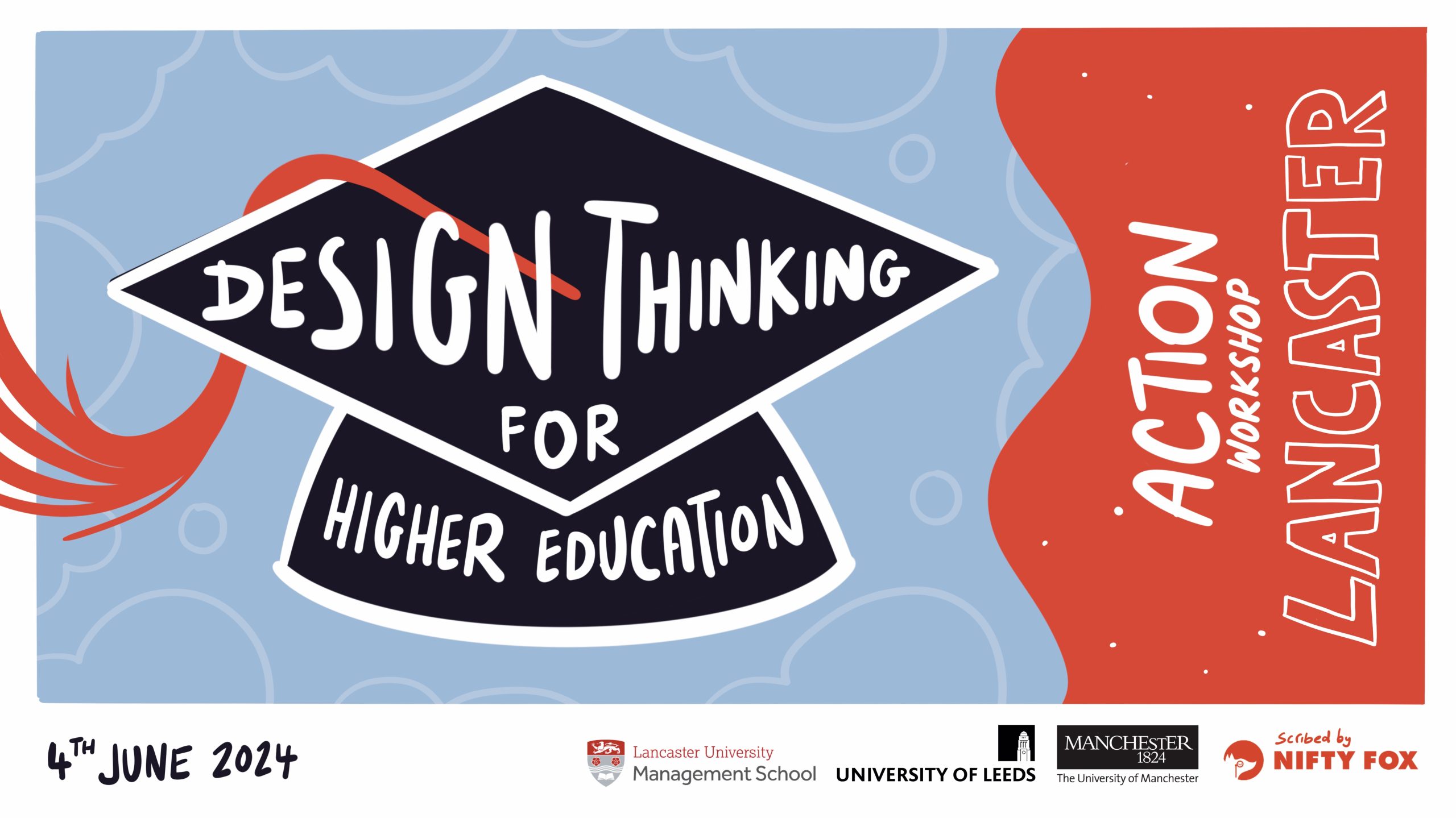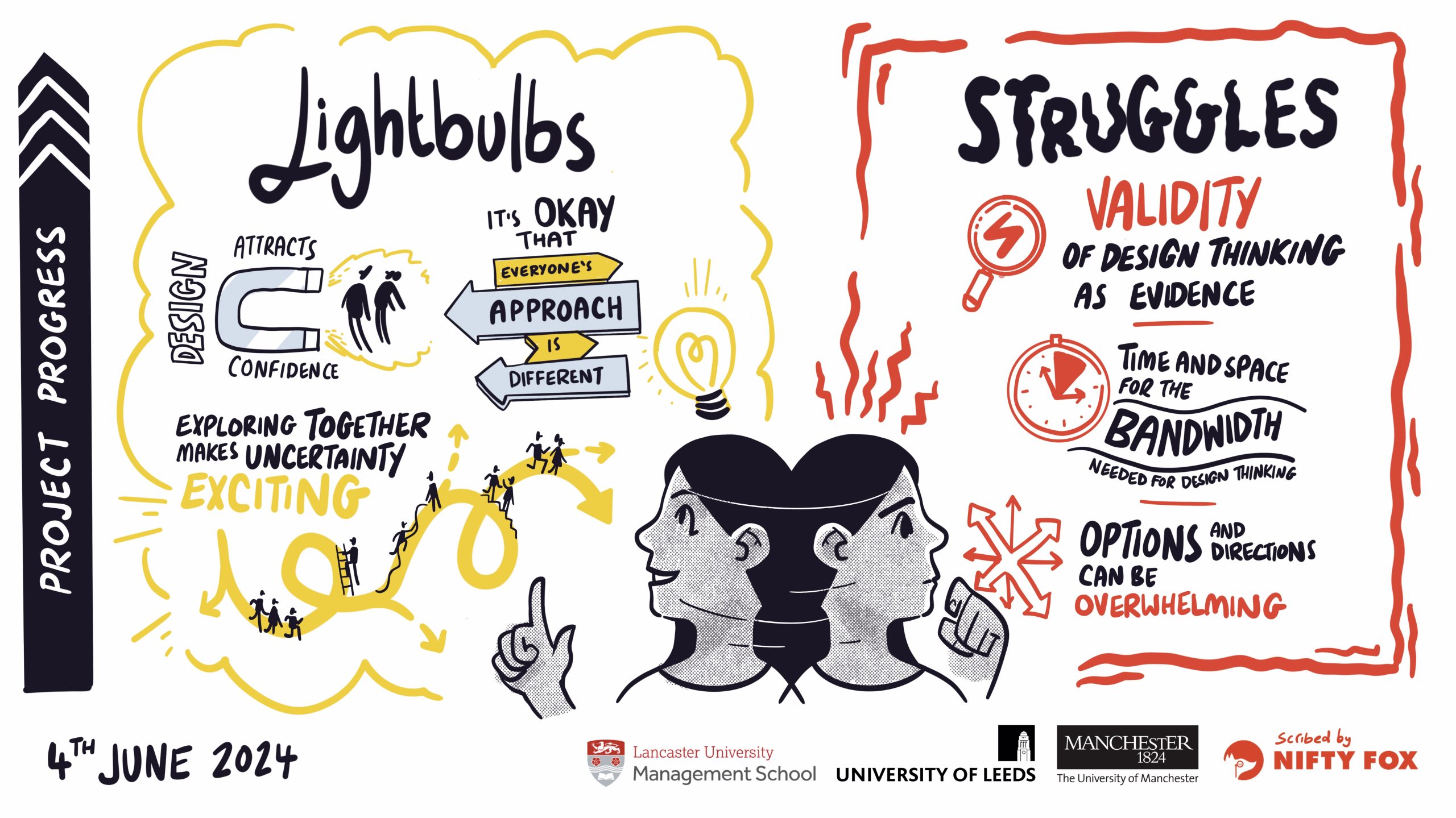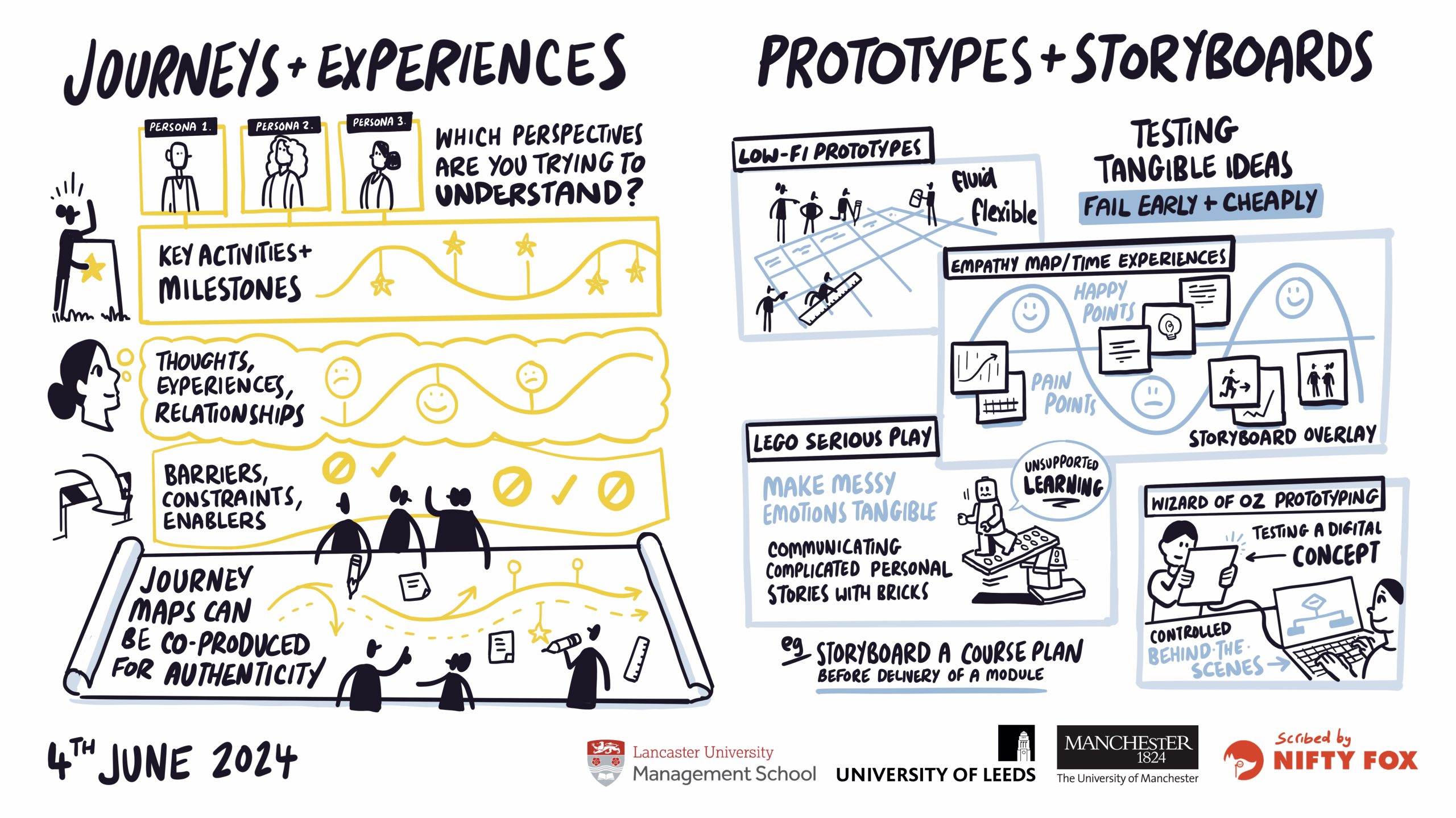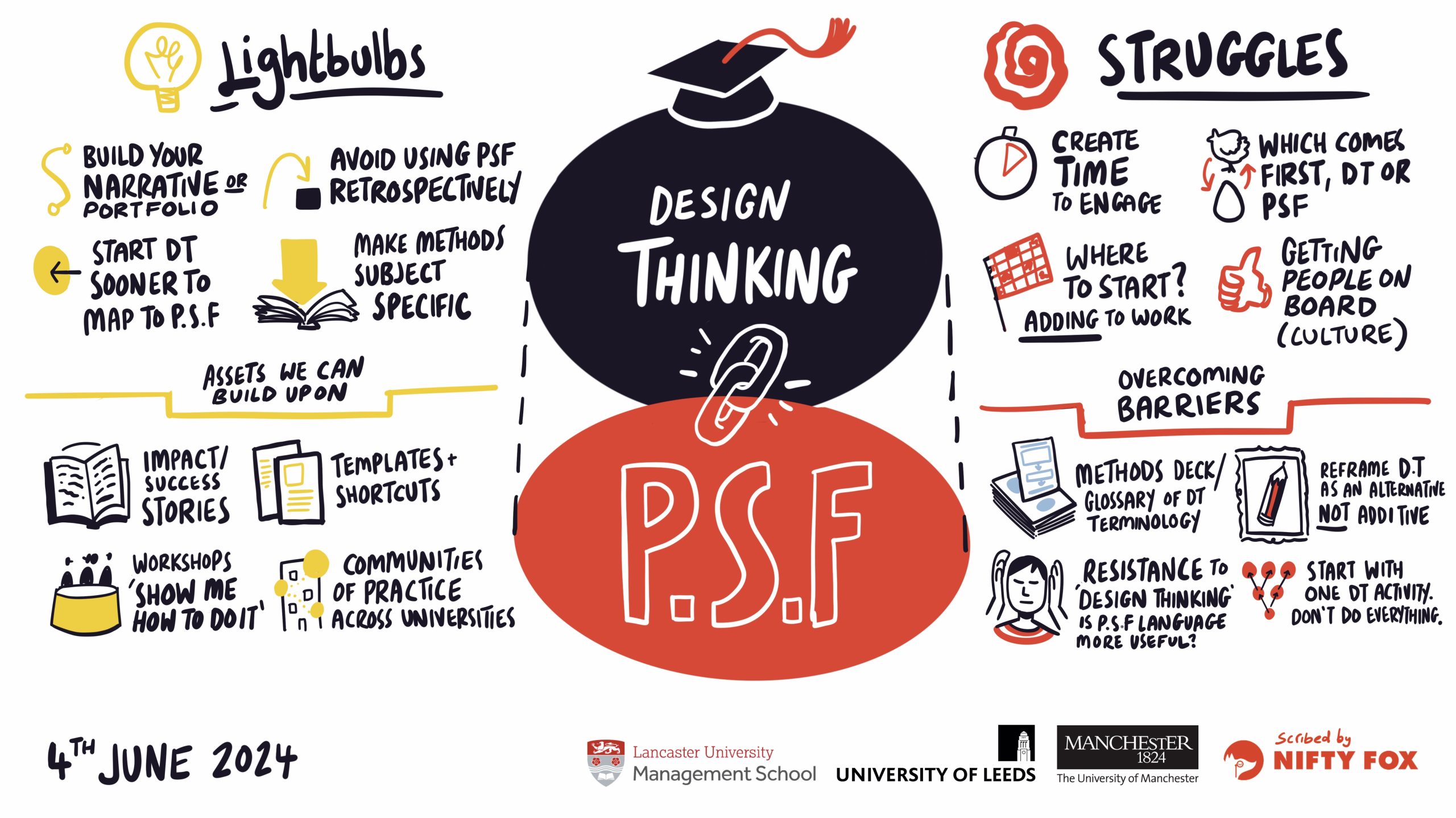Collaboratory 3: ACTION
4th June 2024, Lancaster University (37 colleagues from the HE sector and design organisations).
Objective: Develop a portfolio of DT prototypes and test them with participants to establish deeper understanding of possible enablers for DT to be applied in education.
(all images in this section have been created by our project partner Nifty Fox during the first collboratory depicting our discussions and providing visual documentation of the participants input.)
How did we get on?
 In this last collboratory of the project, we were keen to test some of the prototypes that have been developed as a result of the first two collaboratories. We also wanted to reflect on our learning journey throughout this project and inform our final outputs with participants’ own reflections. “Messy thinking is an important part of the process.”, a note left to us by one of the participants, summarises the notion of the project. Allowing ourselves to pause and experiment, make mistakes and move forward has generated deeper and more meaningful outcomes for us all.
In this last collboratory of the project, we were keen to test some of the prototypes that have been developed as a result of the first two collaboratories. We also wanted to reflect on our learning journey throughout this project and inform our final outputs with participants’ own reflections. “Messy thinking is an important part of the process.”, a note left to us by one of the participants, summarises the notion of the project. Allowing ourselves to pause and experiment, make mistakes and move forward has generated deeper and more meaningful outcomes for us all.Lightbulbs and Struggles
 Reflection and sharing our ups and downs has been an integral part of the project. We kicked off with the project team’s Lightbulbs and Struggles and a debrief focused on the project progress. Connecting PSF and DT has brought many lightbulb moments to us realising that many of us already practice human-centricity and creativity on education without calling it design thinking. The main lightbulb for all of us has been the confirmation of our long-standing niggle – it is only possible to understand DT through experience. Most participants have found love for collaboration and supportive nature of design once they have experienced it. This lightbulb has also become a part of our struggle. Design thinking is experiential, so to ‘see’ its value you need to experience it, so on-boarding is a leap of faith for both someone new to DT and the participants. This has given us inspiration for our next activity…
Reflection and sharing our ups and downs has been an integral part of the project. We kicked off with the project team’s Lightbulbs and Struggles and a debrief focused on the project progress. Connecting PSF and DT has brought many lightbulb moments to us realising that many of us already practice human-centricity and creativity on education without calling it design thinking. The main lightbulb for all of us has been the confirmation of our long-standing niggle – it is only possible to understand DT through experience. Most participants have found love for collaboration and supportive nature of design once they have experienced it. This lightbulb has also become a part of our struggle. Design thinking is experiential, so to ‘see’ its value you need to experience it, so on-boarding is a leap of faith for both someone new to DT and the participants. This has given us inspiration for our next activity…
 And so we fed the penguins…
And so we fed the penguins…
The experiential nature of DT helped us consider how we might draw participants into the core of the DT doing and help them connect the DT practice to the PSF framework. Don’t worry, no animals were harmed in the process. We were simply inspired by the ZOO feeding events and designed the activity as four ACTION stations providing participants a choice of two. Well, it was an energising experience for all of us.
- Empathy and Insights
- Journeys and Experiences
- Ideas and Choices
- Prototypes and Stories
Each station provided participants with two prototypes of the connection between DT and PSF leading to reflection that was unpacked after lunch. It was fun, fast, engaging and as one of our participants put it: “The session has given me lots of ideas (perhaps too many!) and it is a great opportunity to learn from others.”
The two perspectives that the participants tested helped us understand what may enable educators to become more collaborative and connected through DT in order to integrate PSF framework into their daily practice as a continuous enhancement process.
Has it worked?
 After lunch we retreated into a calmer environment to digest the sarnies, refill our coffee cups and recap what has just happened … Bringing back the Lighbulbs and Struggles prompts, we collectively worked in small groups to reflect on the DT experience debating notions of transitions from “I” to “we”, from silos to systems and from tools to mindsets. We could clearly see the opportunity for human-powered education through DT bringing collaboration to the heart of what we do underpinned by the authentic and egalitarian leadership. In practical terms, we all also saw an opportunity for a toolkit development, something tangible that would give us that guide towards the first steps for embracing DT and connecting it to our education practice.
After lunch we retreated into a calmer environment to digest the sarnies, refill our coffee cups and recap what has just happened … Bringing back the Lighbulbs and Struggles prompts, we collectively worked in small groups to reflect on the DT experience debating notions of transitions from “I” to “we”, from silos to systems and from tools to mindsets. We could clearly see the opportunity for human-powered education through DT bringing collaboration to the heart of what we do underpinned by the authentic and egalitarian leadership. In practical terms, we all also saw an opportunity for a toolkit development, something tangible that would give us that guide towards the first steps for embracing DT and connecting it to our education practice.What next?
The project has taught us many things, about ourselves, the energy in our education system, the drive and creativity and the usual constraints due to time and other pressures that we encounter in our daily lives. We have learnt that the “way-in” to DT through simple enablers can be achieved and taking the feedback form our participants, we will elaborate our prototypes that will be developed into the Advance HE assets over summer.
Thank you all for your kindness, commitment and energy to make our education human-powered!